Characterizing the Sound-Scattering Layer and Its Environmental Drivers in the North Equatorial Current of the Central and Western Pacific Ocean
Abstract
1. Introduction
2. Materials and Methods
2.1. Survey Information
2.2. Data Collection
2.3. Data Processing
2.4. Solar Altitude Angle Acquisition
2.5. Generalized Additive Model
3. Results and Analysis
3.1. Vertical Distribution of Environmental Data at Each Station
3.2. Information about the Catch
3.3. General Characteristics of Sound Scattering
3.4. Vertical Distribution of Average Sv in Different Water Layers
3.5. Diel Variation of Scattering Strength
3.6. Covariance Test of Predictor Variables
3.7. Factorial Significance Test
3.8. GAM Test Results
3.9. Relationship between Scattering Strength and Environmental Factors
4. Discussion
5. Conclusions
Author Contributions
Funding
Institutional Review Board Statement
Informed Consent Statement
Data Availability Statement
Acknowledgments
Conflicts of Interest
References
- Guo, J.R.; Liu, Y.L.; Song, J.; Bao, X.W.; Li, Y.; Chen, S.Y.; Yang, J.K. The west boundary bifurcation line of the North Equatorial Current in the Pacific changes features. J. Ocean Univ. China 2015, 14, 957–968. [Google Scholar] [CrossRef]
- Tan, S.W.; Zhou, H. The observed impacts of the two types of El Niño on the North Equatorial Countercurrent in the Pacific Ocean. Geophys. Res. Lett. 2018, 45, 493–500. [Google Scholar] [CrossRef]
- Chen, H.; Shi, J.; Jin, Y.S.; Geng, T.; Li, C.; Zhang, X.Z. Warm and cold episodes in western Pacific warm pool and their linkage with ENSO asymmetry and diversity. J. Geophys. Res. Oceans 2021, 126, e2021J–e17287J. [Google Scholar] [CrossRef]
- Lin, M.; Wang, C.G.; Wang, Y.G.; Xiang, P.; Wang, Y.; Lian, G.S.; Chen, R.X.; Chen, X.Y.; Ye, Y.Y.; Dai, Y.Y. Zooplanktonic diversity in the western Pacific. Biodivers. Sci. 2011, 19, 646–654. [Google Scholar]
- Davison, P.C.; Checkley, D.M., Jr.; Koslow, J.A.; Barlow, J. Carbon export mediated by mesopelagic fishes in the northeast Pacific Ocean. Prog. Oceanogr. 2013, 116, 14–30. [Google Scholar] [CrossRef]
- Hylander, S.; Larsson, N.; Hansson, L. Zooplankton vertical migration and plasticity of pigmentation arising from simultaneous UV and predation threats. Limnol. Oceanogr. 2009, 54, 483–491. [Google Scholar] [CrossRef]
- Kang, M.; Kang, J.; Kim, M.; Nam, S.; Choi, Y.; Kang, D. Sound Scattering Layers Within and Beyond the Seychelles-Chagos Thermocline Ridge in the Southwest Indian Ocean. Front. Mar. Sci. 2021, 8, 769414. [Google Scholar] [CrossRef]
- Takahashi, K.; Kuwata, A.; Sugisaki, H.; Uchikawa, K.; Saito, H. Downward carbon transport by diel vertical migration of the copepods Metridia pacifica and Metridia okhotensis in the Oyashio region of the western subarctic Pacific Ocean. Deep Sea Res. Part I Oceanogr. Res. Pap. 2009, 56, 1777–1791. [Google Scholar] [CrossRef]
- Ducklow, H.W.; Steinberg, D.K.; Buesseler, K.O. Upper ocean carbon export and the biological pump. Oceanography 2001, 14, 50–58. [Google Scholar] [CrossRef]
- Proud, R.; Cox, M.J.; Le Guen, C.; Brierley, A.S. Fine-scale depth structure of pelagic communities throughout the global ocean based on acoustic sound scattering layers. Mar. Ecol. Prog. Ser. 2018, 598, 35–48. [Google Scholar] [CrossRef]
- Bianchi, D.; Stock, C.; Galbraith, E.D.; Sarmiento, J.L. Diel vertical migration: Ecological controls and impacts on the biological pump in a one-dimensional ocean model. Global Biogeochem. Cycles 2013, 27, 478–491. [Google Scholar] [CrossRef]
- Priou, P.; Nikolopoulos, A.; Flores, H.; Gradinger, R.; Kunisch, E.; Katlein, C.; Castellani, G.; Linders, T.; Berge, J.; Fisher, J.A. Dense mesopelagic sound scattering layer and vertical segregation of pelagic organisms at the Arctic-Atlantic gateway during the midnight sun. Prog. Oceanogr. 2021, 196, 102611. [Google Scholar] [CrossRef]
- Norheim, E.; Klevjer, T.A.; Aksnes, D.L. Evidence for light-controlled migration amplitude of a sound scattering layer in the Norwegian Sea. Mar. Ecol. Prog. Ser. 2016, 551, 45–52. [Google Scholar] [CrossRef]
- Flagg, C.N.; Smith, S.L. On the use of the acoustic Doppler current profiler to measure zooplankton abundance. Deep Sea Res. Part I Oceanogr. Res. Pap. 1989, 36, 455–474. [Google Scholar] [CrossRef]
- Ashjian, C.J.; Smith, S.L.; Flagg, C.N.; Mariano, A.J.; Behrens, W.J.; Lane, P.V. The influence of a Gulf Stream meander on the distribution of zooplankton biomass in the Slope Water, the Gulf Stream, and the Sargasso Sea, described using a shipboard acoustic Doppler current profiler. Deep Sea Res. Part I Oceanogr. Res. Pap. 1994, 41, 23–50. [Google Scholar] [CrossRef]
- Wishner, K.F.; Seibel, B.A.; Roman, C.; Deutsch, C.; Outram, D.; Shaw, C.T.; Birk, M.A.; Mislan, K.; Adams, T.J.; Moore, D. Ocean deoxygenation and zooplankton: Very small oxygen differences matter. Sci. Adv. 2018, 4, u5180. [Google Scholar] [CrossRef]
- Xu, Y.J.; Zhao, L.; Yuan, Y. The diel vertical migration of zooplankton observed by an acoustic Doppler current profiler and particle size analyzer in the East China Sea. Acta Oceanol. Sin. 2016, 38, 124–131. [Google Scholar]
- Sourisseau, M.; Simard, Y.; Saucier, F.J. Krill diel vertical migration fine dynamics, nocturnal overturns, and their roles for aggregation in stratified flows. Can. J. Fish. Aquat. Sci. 2008, 65, 574–587. [Google Scholar] [CrossRef]
- Whitmore, B.M.; Nickels, C.F.; Ohman, M.D. A comparison between Zooglider and shipboard net and acoustic mesozooplankton sensing systems. J. Plankton Res. 2019, 41, 521–533. [Google Scholar] [CrossRef]
- Murase, H.; Nagashima, H.; Yonezaki, S.; Matsukura, R.; Kitakado, T. Application of a generalized additive model (GAM) to reveal relationships between environmental factors and distributions of pelagic fish and krill: A case study in Sendai Bay, Japan. ICES J. Mar. Sci. 2009, 66, 1417–1424. [Google Scholar] [CrossRef]
- Kim, J.Y.; Lee, J.B.; Suh, Y. Oceanographic indicators for the occurrence of anchovy eggs inferred from generalized additive models. Fish. Aquat. Sci. 2020, 23, 19. [Google Scholar] [CrossRef]
- Bigelow, K.A.; Boggs, C.H.; He, X.I. Environmental effects on swordfish and blue shark catch rates in the US North Pacific longline fishery. Fish. Oceanogr. 1999, 8, 178–198. [Google Scholar] [CrossRef]
- Yalçın, E.; Gurbet, R. Environmental Influences on the Spatio-Temporal Distribution of European Hake (Merluccius merluccius) in Izmir Bay, Aegean Sea. Turk. J. Fish. Aquat. Sci. 2016, 16, 1–14. [Google Scholar] [CrossRef]
- Feng, Y.T.; Shi, H.Y.; Hou, G.; Zhao, H.; Dong, C.M. Relationships between environmental variables and spatial and temporal distribution of jack mackerel (Trachurus japonicus) in the Beibu Gulf, South China Sea. PeerJ 2021, 9, e12337. [Google Scholar] [CrossRef] [PubMed]
- Khan, A.M.; Nasution, A.M.; Purba, N.P.; Rizal, A.; Hamdani, H.; Dewanti, L.P.; Nurruhwati, I.; Sahidin, A.; Supriyadi, D.; Herawati, H. Oceanographic characteristics at fish aggregating device sites for tuna pole-and-line fishery in eastern Indonesia. Fish. Res. 2020, 225, 105471. [Google Scholar] [CrossRef]
- Hughes, K.M.; Dransfeld, L.; Johnson, M.P. Climate and stock influences the spread and locations of catches in the northeast Atlantic mackerel fishery. Fish. Oceanogr. 2015, 24, 540–552. [Google Scholar] [CrossRef]
- Boswell, K.M.; D’Elia, M.; Johnston, M.W.; Mohan, J.A.; Warren, J.D.; Wells, R.D.; Sutton, T.T. Oceanographic structure and light levels drive patterns of sound scattering layers in a low-latitude oceanic system. Front. Mar. Sci. 2020, 7, 51. [Google Scholar] [CrossRef]
- Lee, H.; La, H.S.; Kang, D.; Lee, S. Vertical distribution of the sound-scattering layer in the Amundsen Sea, Antarctica. Polar Sci. 2018, 15, 55–61. [Google Scholar] [CrossRef]
- Yin, X.Q.; Yang, D.T.; Zhao, L.H.; Zhong, R.; Du, R.R. Fishery Resource Evaluation with Hydroacoustic and Remote Sensing in Yangjiang Coastal Waters in Summer. Remote Sens. 2023, 15, 543. [Google Scholar] [CrossRef]
- Darnis, G.; Hobbs, L.; Geoffroy, M.; Grenvald, J.C.; Renaud, P.E.; Berge, J.; Cottier, F.; Kristiansen, S.; Daase, M.; Søreide, J.E. From polar night to midnight sun: Diel vertical migration, metabolism and biogeochemical role of zooplankton in a high Arctic fjord (Kongsfjorden, Svalbard). Limnol. Oceanogr. 2017, 62, 1586–1605. [Google Scholar] [CrossRef]
- Burd, A.C.; Lee, A.J. The sonic scattering layer in the sea. Nature 1951, 167, 624–626. [Google Scholar] [CrossRef]
- Demer, D.; Berger, L.; Bernasconi, M.; Bethke, E.; Boswell, K.; Chu, D.; Domokos, R.; Dunford, A.; Fassler, S.; Gauthier, S. Calibration of acoustic instruments. ICES Coop. Res. Rep. 2015, 326, 133pp. [Google Scholar]
- Mouget, A.; Brehmer, P.; Perrot, Y.; Uanivi, U.; Diogoul, N.; El Ayoubi, S.; Jeyid, M.A.; Sarré, A.; Béhagle, N.; Kouassi, A.M. Applying acoustic scattering layer descriptors to depict mid-trophic pelagic organisation: The case of Atlantic African large marine ecosystems continental shelf. Fishes 2022, 7, 86. [Google Scholar] [CrossRef]
- Ariza, A.; Landeira, J.M.; Escánez, A.; Wienerroither, R.; de Soto, N.A.; Røstad, A.; Kaartvedt, S.; Hernández-León, S. Vertical distribution, composition and migratory patterns of acoustic scattering layers in the Canary Islands. J. Mar. Syst. 2016, 157, 82–91. [Google Scholar] [CrossRef]
- Wang, X.; Zhang, J.; Zhao, X. A post-processing method to remove interference noise from acoustic data collected from Antarctic krill fishing vessels. CCAMLR Sci. 2016, 23, 17–30. [Google Scholar]
- Korneliussen, R.J. Measurement and removal of echo integration noise. ICES J. Mar. Sci. 2000, 57, 1204–1217. [Google Scholar] [CrossRef]
- Watkins, J.L.; Brierley, A.S. A post-processing technique to remove background noise from echo integration data. ICES J. Mar. Sci. 1996, 53, 339–344. [Google Scholar] [CrossRef]
- Solar Calculations: Solar Calculator. Available online: https://gml.noaa.gov/grad/solcalc (accessed on 20 February 2023).
- Hastie, T.; Tibshirani, R. Generalized Additive Models. Stat. Sci. 1986, 1, 297–318. [Google Scholar] [CrossRef]
- Han, H.B.; Yang, C.; Zhang, H.; Fang, Z.; Jiang, B.H.; Su, B.; Sui, J.H.; Yan, Y.Z.; Xiang, D.L. Environment variables affect CPUE and spatial distribution of fishing grounds on the light falling gear fishery in the Northwest Indian Ocean at different time scales. Front. Mar. Sci. 2022, 9, 939334. [Google Scholar] [CrossRef]
- Meng, W.Z.; Gong, Y.H.; Wang, X.F.; Tong, J.F.; Han, D.Y.; Chen, J.H.; Wu, J.H. Influence of spatial scale selection of environmental factors on the prediction of distribution of Coilia nasus in Changjiang River Estuary. Fishes 2021, 6, 48. [Google Scholar] [CrossRef]
- Syah, A.F.; Saitoh, S.; Alabia, I.D.; Hirawake, T. Detection of potential fishing zone for Pacific saury (Cololabis saira) using generalized additive model and remotely sensed data. In Proceedings of the IOP Conference Series: Earth and Environmental Science, Zvenigorod, Russia, 4–7 September 2017. [Google Scholar]
- Lee, H.; Cho, S.; Kim, W.; Kang, D. The diel vertical migration of the sound-scattering layer in the Yellow Sea Bottom Cold Water of the southeastern Yellow sea: Focus on its relationship with a temperature structure. Acta Oceanol. Sin. 2013, 32, 44–49. [Google Scholar] [CrossRef]
- Brodziak, J.; Walsh, W.A. Model selection and multimodel inference for standardizing catch rates of bycatch species: A case study of oceanic whitetip shark in the Hawaii-based longline fishery. Can. J. Fish. Aquat. Sci. 2013, 70, 1723–1740. [Google Scholar] [CrossRef]
- Urickr, J. Principles of Underwater Sound, 2nd ed.; McGraw-Hill Book: New York, NY, USA, 1975. [Google Scholar]
- Batzler, W.E.; Vent, R.J. Volume-Scattering Measurements at 12 kc/sec in the Western Pacific. J. Acoust. Soc. Am. 1967, 41, 154–157. [Google Scholar] [CrossRef]
- Li, Q.; Chen, Z.H. Diel Vertial migration of zooplankton in the Kuroshio-Oyashio Mixed Zone based on ADCP echo. Oceanol. Limnol. 2022, 2, 305–319. [Google Scholar]
- Costa, P.L.; Valderrama, P.R.C.; Madureira, L.A.S.P. Relationships between environmental features, distribution and abundance of the Argentine anchovy, Engraulis anchoita, on the South West Atlantic Continental Shelf. Fish. Res. 2016, 173, 229–235. [Google Scholar] [CrossRef]
- Franceschini, G.A.; Bright, T.J.; Caruthers, J.W.; El-Sayed, S.Z.; Vastano, A.C. Effects on migration of marine organisms in the Gulf of Mexico. Nature 1970, 226, 1155–1156. [Google Scholar] [CrossRef]
- Wiafe, G.; Yaqub, H.B.; Mensah, M.A.; Frid, C.L. Impact of climate change on long-term zooplankton biomass in the upwelling region of the Gulf of Guinea. ICES J. Mar. Sci. 2008, 65, 318–324. [Google Scholar] [CrossRef]
- Aksnes, D.L.; Røstad, A.; Kaartvedt, S.; Martinez, U.; Duarte, C.M.; Irigoien, X. Light penetration structures the deep acoustic scattering layers in the global ocean. Sci. Adv. 2017, 3, e1602468. [Google Scholar] [CrossRef]
- Evans, R.A.; Hopkins, C. Distribution and standing stock of zooplankton sound-scattering layers along the north Norwegian coast in February—March, 1978. Sarsia 1981, 66, 147–160. [Google Scholar] [CrossRef]
- Hays, G.C. A review of the adaptive significance and ecosystem consequences of zooplankton diel vertical migrations. Hydrobiologia 2003, 503, 163–170. [Google Scholar] [CrossRef]
- Hu, S.J.; Hu, D.X. Variability of the Pacific North Equatorial Current from repeated shipboard acoustic Doppler current profiler measurements. J. Oceanogr. 2014, 70, 559–571. [Google Scholar] [CrossRef]
- Ge, R.P.; Chen, H.J.; Liu, G.X.; Zhu, Y.Z.; Jiang, Q. Diel vertical migration of mesozooplankton in the northern Yellow Sea. J. Oceanol. Limnol. 2021, 39, 1373–1386. [Google Scholar] [CrossRef]
- Xue, M.H.; Tong, J.F.; Tian, S.Q.; Wang, X.F. Broadband Characteristics of Zooplankton Sound Scattering Layer in the Kuroshio–Oyashio Confluence Region of the Northwest Pacific Ocean in Summer of 2019. J. Mar. Sci. Eng. 2021, 9, 938. [Google Scholar] [CrossRef]

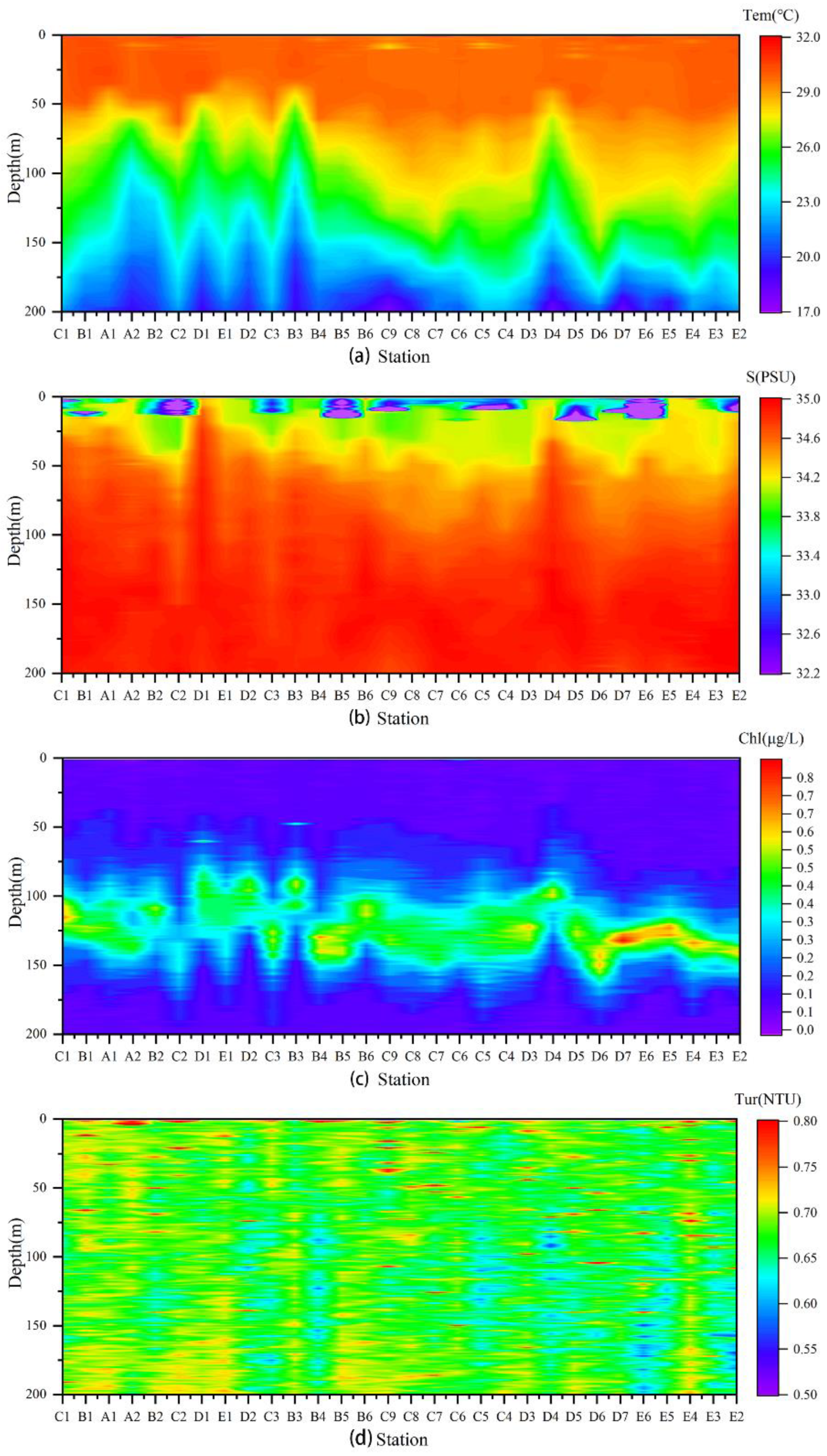
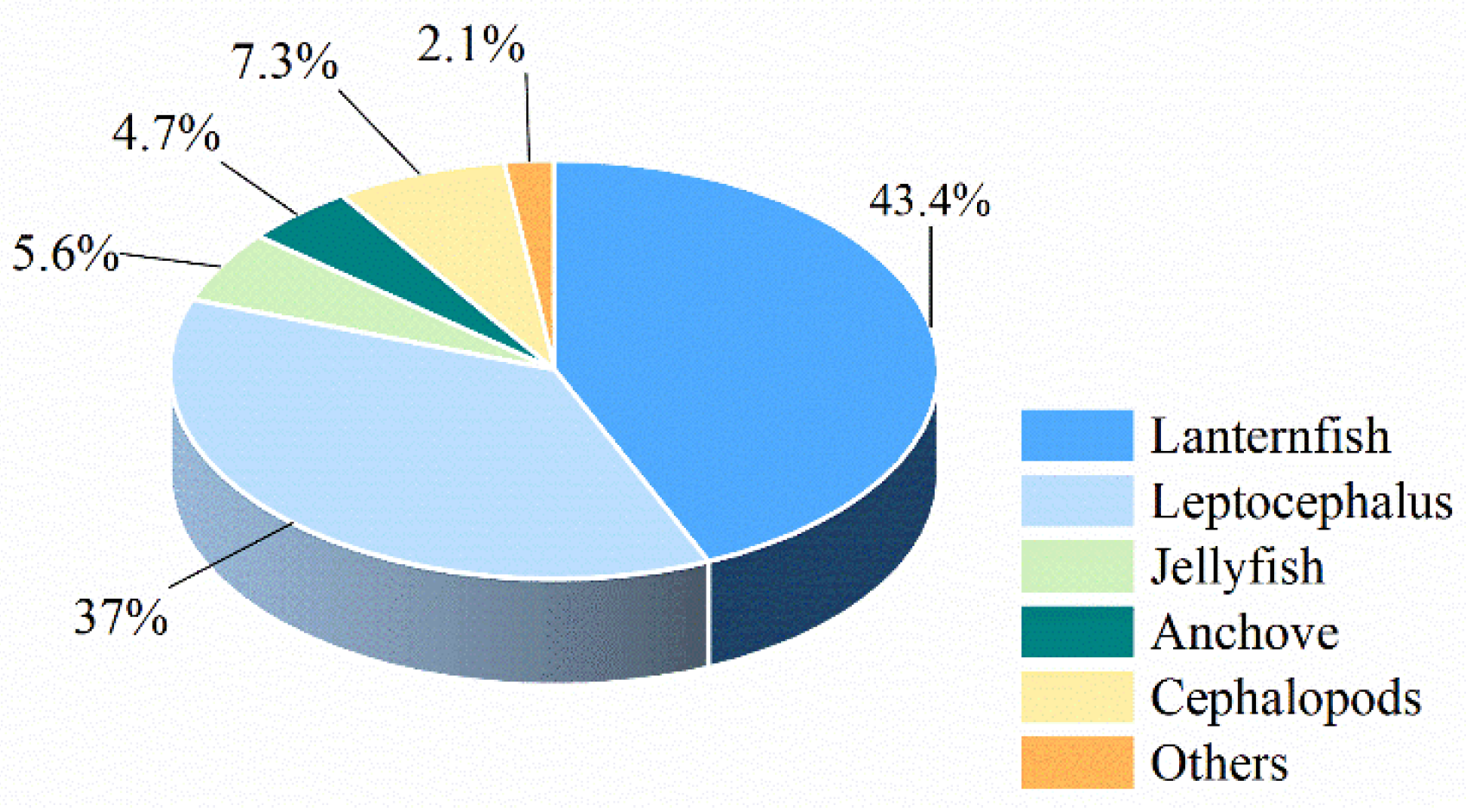
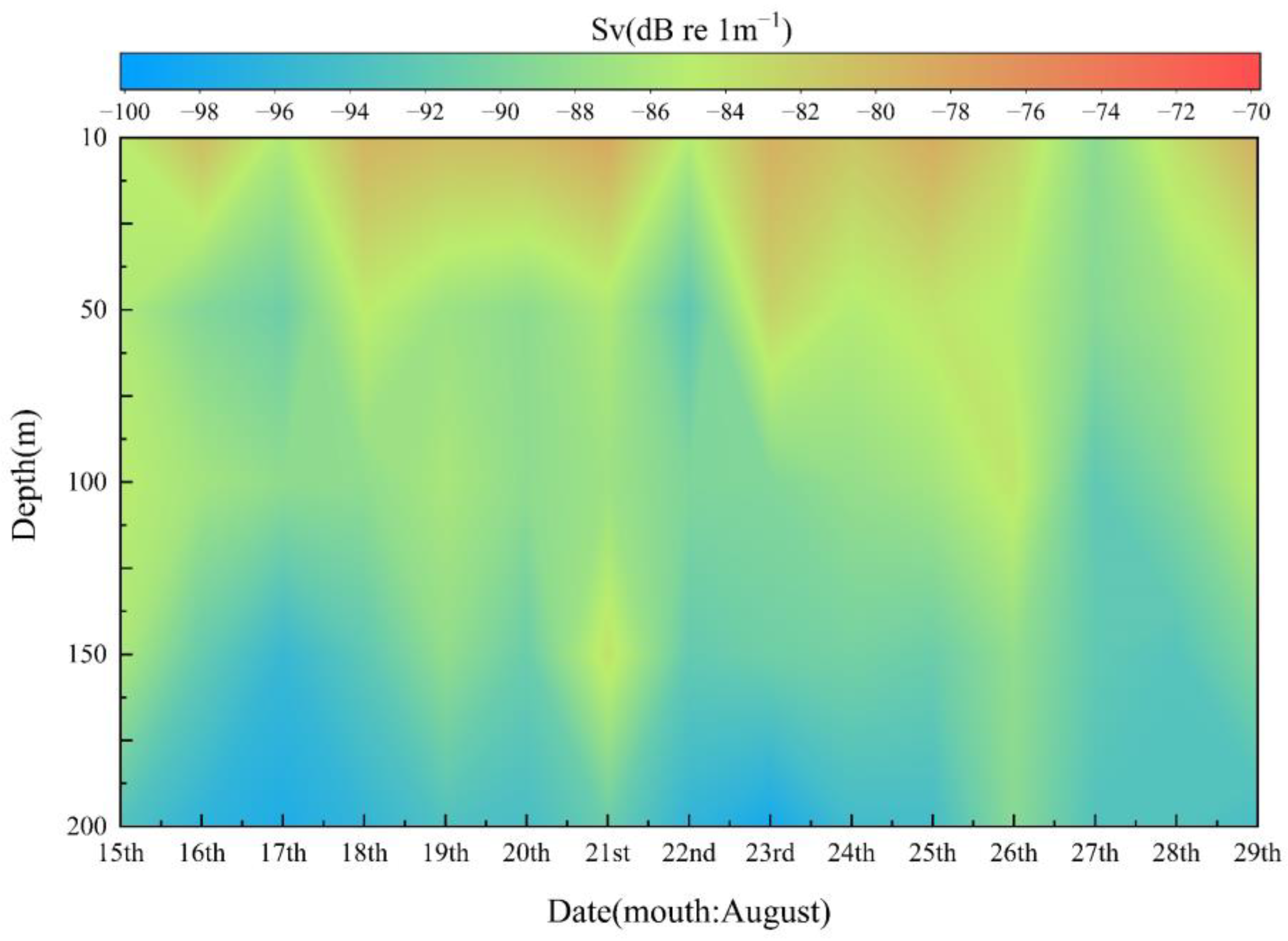
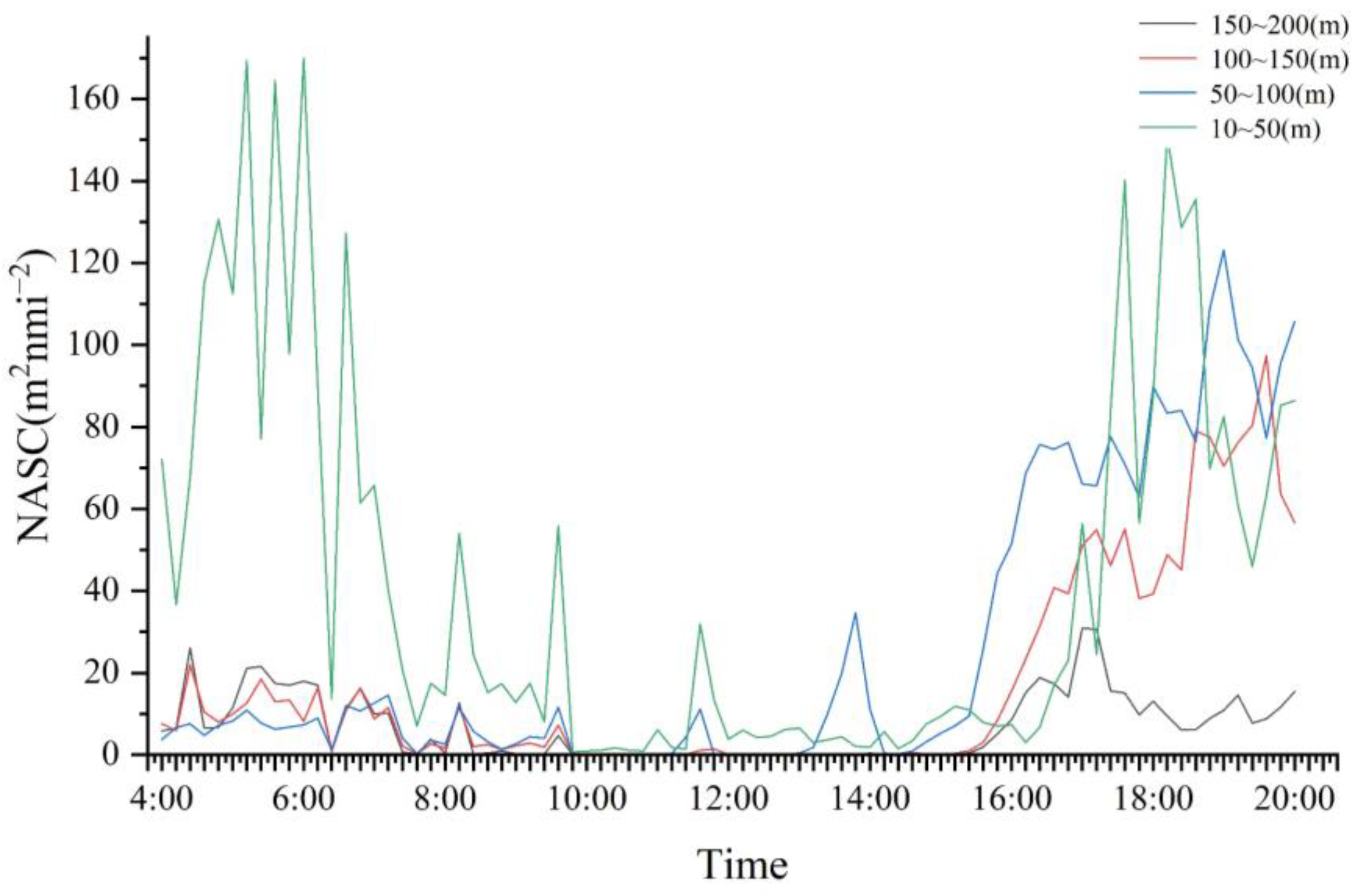
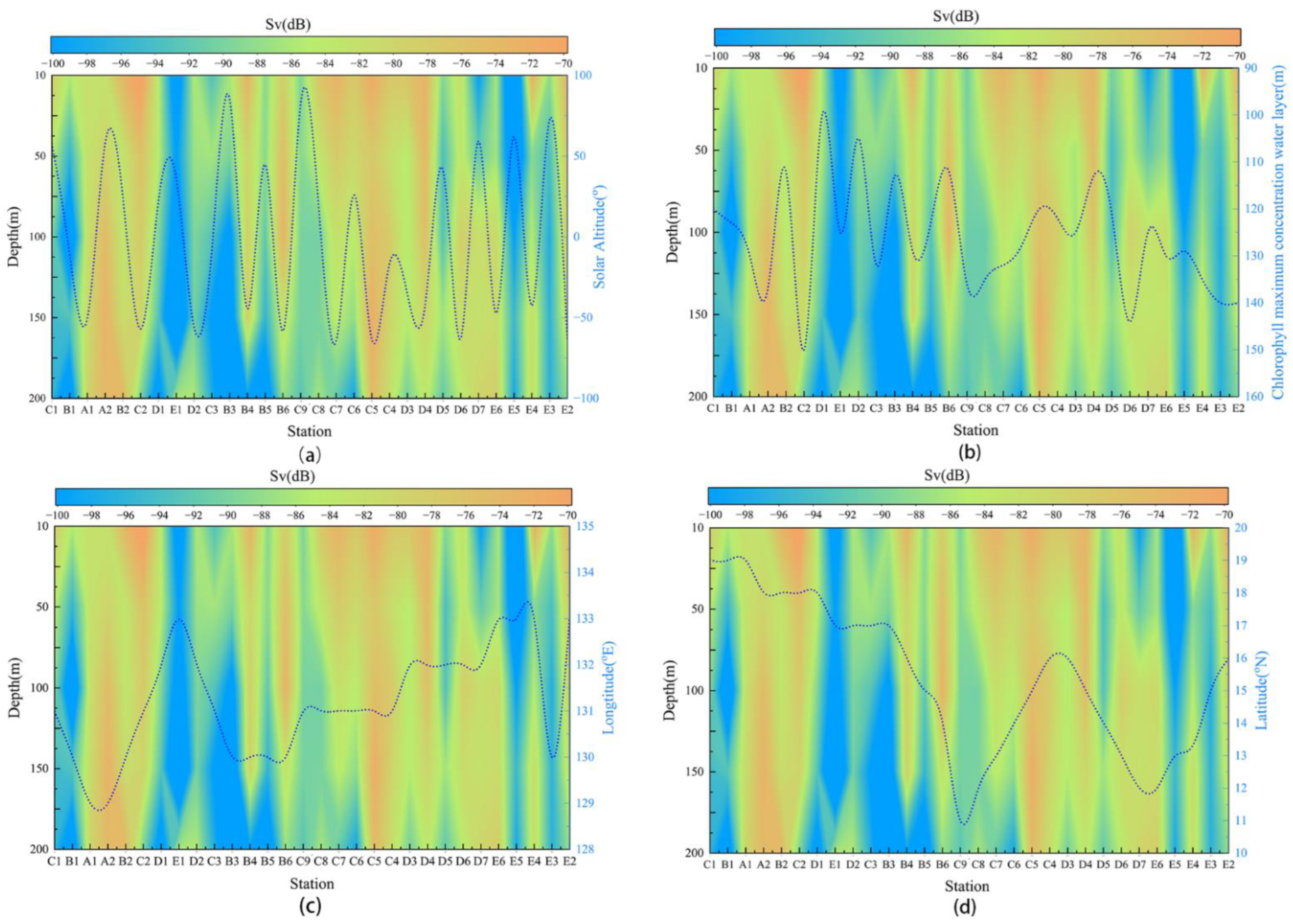
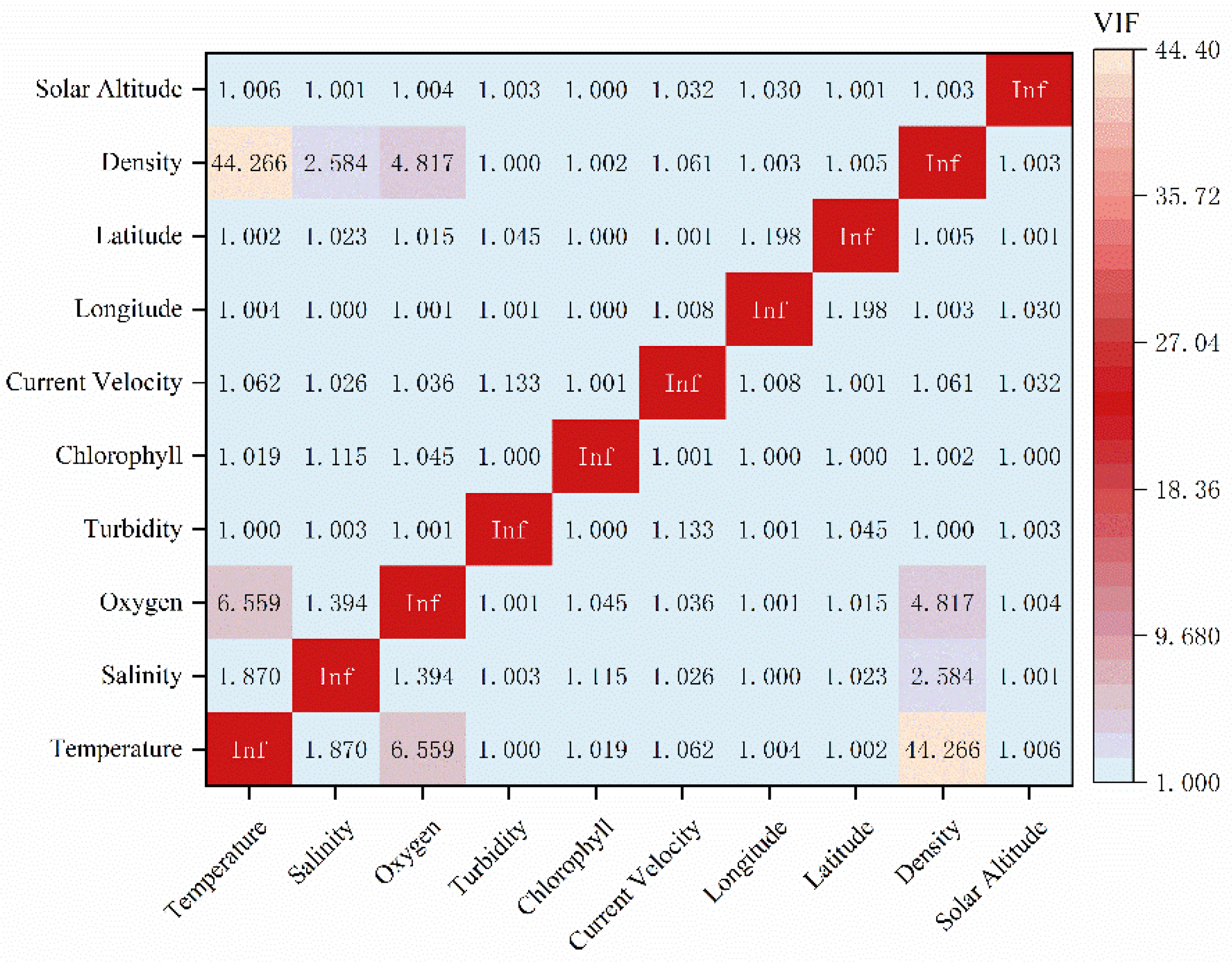
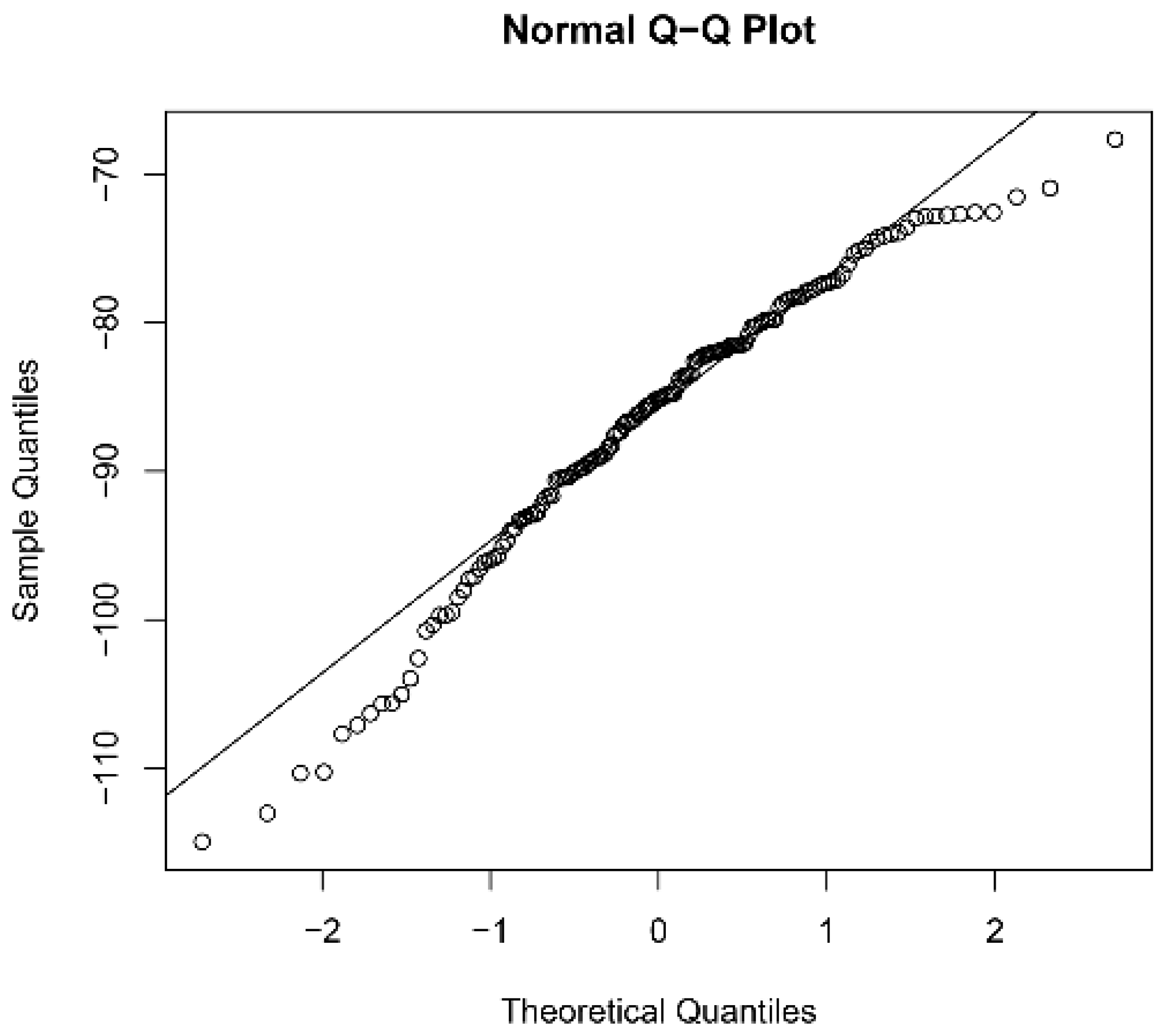

| Transducer Type | ES38–7C |
|---|---|
| Beam type | Splitting |
| Broadband range/kHz | 34~45 |
| Transmit power/W | 2000 |
| Pulse length/ms | 1.024 |
| Pulse interval/ms | 2000 |
| Beam angle/° | 7 |
| Station | Date | Time | Station | Date | Time |
|---|---|---|---|---|---|
| C1 | 15 August 2022 | 10:07 | C8 | 22 August 2022 | 17:04 |
| B1 | 15 August 2022 | 19:31 | C7 | 23 August 2022 | 0:28 |
| A1 | 16 August 2022 | 1:31 | C6 | 23 August 2022 | 16:42 |
| A2 | 16 August 2022 | 10:16 | C5 | 24 August 2022 | 0:20 |
| B2 | 16 August 2022 | 16:59 | C4 | 24 August 2022 | 19:43 |
| C2 | 17 August 2022 | 0:40 | D3 | 25 August 2022 | 3:13 |
| D1 | 17 August 2022 | 7:33 | D4 | 25 August 2022 | 21:19 |
| E1 | 17 August 2022 | 15:55 | D5 | 26 August 2022 | 15:32 |
| D2 | 17 August 2022 | 22:55 | D6 | 26 August 2022 | 23:05 |
| C3 | 18 August 2022 | 5:24 | D7 | 27 August 2022 | 14:19 |
| B3 | 18 August 2022 | 12:15 | E6 | 27 August 2022 | 21:32 |
| B4 | 18 August 2022 | 21:37 | E5 | 28 August 2022 | 14:03 |
| B5 | 19 August 2022 | 15:30 | E4 | 28 August 2022 | 21:12 |
| B6 | 19 August 2022 | 22:51 | E3 | 29 August 2022 | 13:30 |
| C9 | 21 August 2022 | 12:50 | E2 | 29 August 2022 | 23:21 |
| Model Functions | AIC | Accumulation of Deviance Explanation | Coefficient of Determination R2 |
|---|---|---|---|
| Sv ~ s(T) | 1102 | 5.05 | 0.0448 |
| Sv ~ s(T) + s(Tur) | 1097 | 10.10 | 0.8660 |
| Sv ~ s(T) + s(Tur) + s(S) | 1097 | 10.30 | 0.0877 |
| Sv ~ s(T) + s(Tur) + s(Chl) | 1097 | 10.10 | 0.8670 |
| Sv ~ s(T) + s(Tur) +s(Sol) | 1045 | 45.50 | 0.3990 |
| Sv ~ s(T) + s(Tur) + s(Sol) + s(CV) | 1044 | 46.30 | 0.4060 |
| Sv ~ s(T) + s(Tur) + s(Sol) + s(CV) + s(Lon) | 1012 | 59.00 | 0.5500 |
| Sv ~ s(T) + s(Tur) + s(Sol) + s(CV) + s(Lon) + s(Lat) | 989 | 67.20 | 0.6100 |
| Optimal Model | Degree of Freedom | p Value | AIC | Accumulation of Deviance Explanation | Deviance Explanation of Each Factor |
|---|---|---|---|---|---|
| S (Temperature) | 5.095 | 3.27 × 10−5 *** | 1102 | 5.05 | 5.05 |
| S (Turbidity) | 1.152 | 6.05 × 10−3 ** | 1097 | 10.10 | 5.05 |
| S (Solar altitude angle) | 2.232 | <2 × 10−16 *** | 1045 | 45.50 | 35.40 |
| S (Current velocity) | 1.648 | 1.37 × 10−2 * | 1044 | 46.30 | 0.80 |
| S (Latitude) | 4.836 | 2.13 × 10−6 *** | 1012 | 59.00 | 12.70 |
| S (Longitude) | 8.997 | <2 × 10−16 *** | 989 | 67.20 | 8.20 |
Disclaimer/Publisher’s Note: The statements, opinions and data contained in all publications are solely those of the individual author(s) and contributor(s) and not of MDPI and/or the editor(s). MDPI and/or the editor(s) disclaim responsibility for any injury to people or property resulting from any ideas, methods, instructions or products referred to in the content. |
© 2023 by the authors. Licensee MDPI, Basel, Switzerland. This article is an open access article distributed under the terms and conditions of the Creative Commons Attribution (CC BY) license (https://creativecommons.org/licenses/by/4.0/).
Share and Cite
Gao, T.; Tong, J.; Xue, M.; Zhu, Z.; Qiu, Y.; Kindong, R.; Ma, Q.; Li, J. Characterizing the Sound-Scattering Layer and Its Environmental Drivers in the North Equatorial Current of the Central and Western Pacific Ocean. J. Mar. Sci. Eng. 2023, 11, 1477. https://doi.org/10.3390/jmse11071477
Gao T, Tong J, Xue M, Zhu Z, Qiu Y, Kindong R, Ma Q, Li J. Characterizing the Sound-Scattering Layer and Its Environmental Drivers in the North Equatorial Current of the Central and Western Pacific Ocean. Journal of Marine Science and Engineering. 2023; 11(7):1477. https://doi.org/10.3390/jmse11071477
Chicago/Turabian StyleGao, Tianji, Jianfeng Tong, Minghua Xue, Zhenhong Zhu, Yue Qiu, Richard Kindong, Qiuyun Ma, and Jun Li. 2023. "Characterizing the Sound-Scattering Layer and Its Environmental Drivers in the North Equatorial Current of the Central and Western Pacific Ocean" Journal of Marine Science and Engineering 11, no. 7: 1477. https://doi.org/10.3390/jmse11071477
APA StyleGao, T., Tong, J., Xue, M., Zhu, Z., Qiu, Y., Kindong, R., Ma, Q., & Li, J. (2023). Characterizing the Sound-Scattering Layer and Its Environmental Drivers in the North Equatorial Current of the Central and Western Pacific Ocean. Journal of Marine Science and Engineering, 11(7), 1477. https://doi.org/10.3390/jmse11071477









